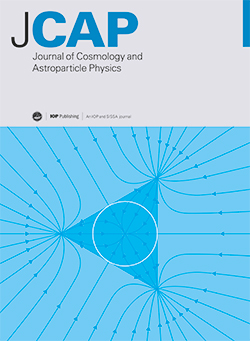强透镜的弱透镜:超越潮汐机制
IF 5.3
2区 物理与天体物理
Q1 ASTRONOMY & ASTROPHYSICS
Journal of Cosmology and Astroparticle Physics
Pub Date : 2024-08-12
DOI:10.1088/1475-7516/2024/08/021
引用次数: 0
摘要
对强透镜图像的分析通常涉及外部辐辏和剪切,其目的是模拟主透镜上方沿视线方向的扰动效应。这种对视线扰动的描述假定相应的引力场可以在潮汐机制中处理。再进一步,就会引入额外的效应,即迄今为止在强透镜中被忽视的挠曲效应。在这项工作中,我们为视线屈曲建立了一个最小模型,为透镜模型增加了四个新的复杂参数。与辐辏和剪切相反,视线弯曲不能投射到主透镜平面上。对于ΛCDM 宇宙学,我们预测在星系尺度上典型的视线屈曲为 10-3 弧秒-1。在透镜建模中忽略它的影响,会使其他参数的恢复出现偏差;特别是,视线切变的偏差可达 2σ。在我们的最小框架中考虑到视线弯曲,可以恢复精度,但代价是降低精度。以目前的成像能力,在单个强透镜图像上不太可能测量到视线弯曲;因此必须将其视为一个干扰参数,而不是一个可观测的参数。本文章由计算机程序翻译,如有差异,请以英文原文为准。
Weak lensing of strong lensing: beyond the tidal regime
The analysis of strong lensing images usually involves an external convergence and shear, which are meant to model the effect of perturbations along the line of sight, on top of the main lens. Such a description of line-of-sight perturbations supposes that the corresponding gravitational fields can be treated in the tidal regime. Going one step further introduces additional effects, known as flexion, which have been hitherto neglected in strong lensing. In this work, we build a minimal model for the line-of-sight flexion, which adds four new complex parameters to the lens model. Contrary to convergence and shear, the line-of-sight flexion cannot be projected onto the main lens plane. For a ΛCDM cosmology, we predict the typical line-of-sight flexion to be on the order of 10-3 arcsec-1 on galactic scales. Neglecting its effect in lens modelling is found to bias the recovery of other parameters; in particular, the line-of-sight shear can be biased up to 2σ. Accounting for the line-of-sight flexion in our minimal framework restores accuracy, at the cost of degrading precision. With current imaging capabilities, the line-of-sight flexion is unlikely to be measurable on individual strong lensing images; it must therefore be considered a nuisance parameter rather than an observable in its own right.
求助全文
通过发布文献求助,成功后即可免费获取论文全文。
去求助
来源期刊

Journal of Cosmology and Astroparticle Physics
地学天文-天文与天体物理
CiteScore
10.20
自引率
23.40%
发文量
632
审稿时长
1 months
期刊介绍:
Journal of Cosmology and Astroparticle Physics (JCAP) encompasses theoretical, observational and experimental areas as well as computation and simulation. The journal covers the latest developments in the theory of all fundamental interactions and their cosmological implications (e.g. M-theory and cosmology, brane cosmology). JCAP''s coverage also includes topics such as formation, dynamics and clustering of galaxies, pre-galactic star formation, x-ray astronomy, radio astronomy, gravitational lensing, active galactic nuclei, intergalactic and interstellar matter.
 求助内容:
求助内容: 应助结果提醒方式:
应助结果提醒方式:


